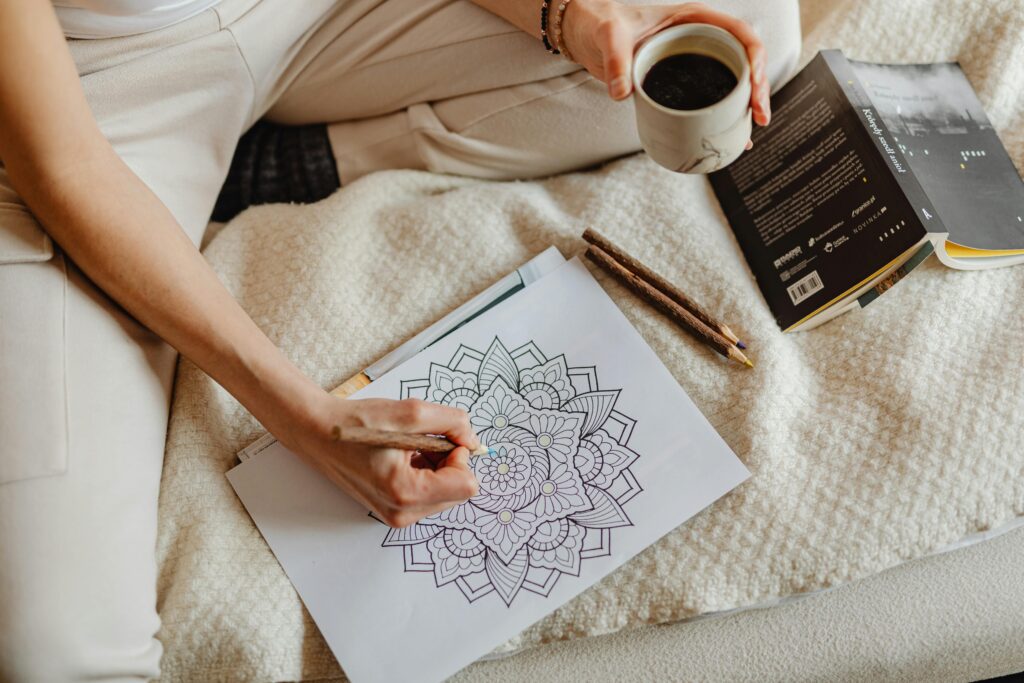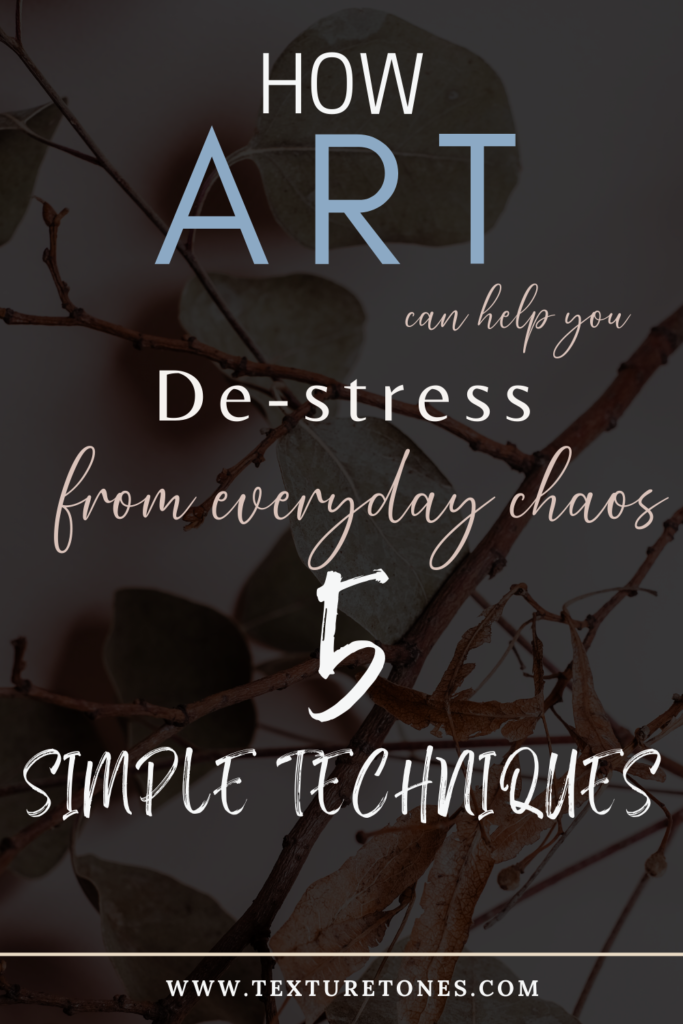Disclaimer: Some links in this post may be affiliate links. This means that if you purchase something through that link, I get a small commission, at no extra cost to you.

I’m a creative person, and for me to de- stress, I need to paint, write, or even just scribble to let my emotions out.
One of the powerful tools to manage stress and express emotions is what I have come across and read about is Art Therapy.
It’s a form of therapy where creative activities like drawing, painting, or sculpting are used as a tool to help people explore their feelings, manage anxiety, and improve their mental well-being.
Inorder to indulge in art therapy, you don’t have to be an artist —all you need to do is just pick up a pencil or brush and allow your thoughts to flow. Many of these techniques are guided by experienced art therapists who tailor the process to fit your specific needs and goals.
I have never been to an art therapist, however as an artist I do find peace with my art. And I definitely know from my personal experience that how much these simple art techniques can help.
Art therapy can be particularly useful for those who struggle to express their emotions verbally or prefer a more hands-on, creative way to unwind. However, not everyone has access to a licensed art therapist, and that’s okay. The good news is that you don’t need to be in a professional setting to experience the benefits of art. You can still tap into the healing power of creativity on your own.
Let’s explore some simple ways art can help you de-stress and bring a sense of calm to your mind. Below, I’ve outlined a 5-day journey to help you embrace calm through art—one creative step at a time.
Disclaimer: I am not a licensed therapist. These activities are for relaxation purposes only. If you are dealing with chronic issues, it is strongly advised to consult with a licensed professional for appropriate support and guidance.
Here are a few simple, yet effective techniques that you can try at home.
1. Find your Calm through Coloring

Coloring isn’t just for kids —it has become a popular stress-relief activity for people of all ages, particularly with the rise of adult coloring books.
But why do you think such a simple activity as coloring can have a calming effect on the mind?
When we color, our brain focuses on repetitive motions, which helps quieten the constant chatter of thoughts in our head. This takes your attention away and helps us find a moment of peace. Personally, I have found it similar to meditation as both involves focus on the present and letting go of unwanted thoughts.
Of all what I have tried, my absolute favorite is drawing and coloring Mandalas. Mandalas are intricate, circular designs that have been used in spiritual and meditative practices for centuries, particularly in Hinduism and Buddhism. These beautiful, symmetrical patterns are known for their symbolic meanings, representing wholeness, balance, and the universe.
But what makes them particularly powerful for stress relief?
Coloring mandalas has been found to activate the brain’s “relaxation response,” which is similar to how meditation works. The circular, balanced structure of a mandala naturally draws you into a state of focus, helping to lower anxiety and create a sense of inner calm. In fact, studies have shown that coloring mandalas can significantly reduce stress and improve overall well-being.
If you are someone who gets overwhelmed with intricate designs, try the very simple ones and gradually move ahead with more complex designs.
You don’t need any fancy supplies—just grab a mandala coloring book or any adult coloring book and some colored pencils, and you’re ready to go.
Read: Can Coloring Mandalas Reduce Anxiety?
How to Try It:
- Choose a coloring page with simple patterns to begin with.
- Use colored pencils or markers and spend 15-20 minutes filling in the spaces.
- Focus on the colors you find most soothing, and let the process calm your mind.
- Try some interesting color schemes. For example, a leaf need not be always green. Try with colors like blue or orange or any color of your choice.
Alternatively , here is a recommendation to buy Mandala and Floral coloring Book
2. Freedom with Doodling

Doodling is an aimless drawing with no specific outcomes in mind. And thats the beauty of it. It is more than just a simple pastime; it has been shown to enhance memory, focus, and cognitive function.
Engaging in doodling can help calm the mind. The repetitive motion of drawing allows individuals to enter a meditative state, which can alleviate feelings of stress. Research shows that this process of drawing without any intention encourages relaxation, as it distracts the brain from anxious thoughts and also promotes creative thinking.
There was also a study conducted by Professor Jackie Andrade and published in Applied Cognitive Psychology. It showed that doodling (a more structured form of scribbling) can help with memory recall.
In the study, participants who doodled while listening to a monotonous message were able to recall 29% more information compared to those who did not doodle. This suggests that engaging in a simple, repetitive activity like doodling or scribbling can help maintain focus and prevent daydreaming during tasks that might otherwise lead to distractions.
It is an accessible and enjoyable activity that can significantly help manage stress and anxiety. It combines creativity with relaxation, offering a therapeutic outlet for those feeling overwhelmed.
How to Try It:
- Take a blank sheet of paper and any drawing tool (pen, pencil, or marker).
- Spend 10-15 minutes doodling freely, without trying to create anything specific.
- Focus on the sensation of the pen moving on the paper and let your thoughts flow.
3. Connecting with Nature through Simple Sketches

Drawing elements of nature can be a grounding and peaceful experience.
Have you ever taken a close look at nature? When you do, you’ll find a world full of intricate designs, rich textures, and amazing patterns. Nature is a master artist. Try to notice the delicate veins in a leaf, the smooth curves of a seashell, or the beautiful colors of a butterfly’s wings.
The diverse textures found outdoors—from the rough bark of a tree to the soft petals of a flower to the symmetrical and geometric patterns, such as the hexagonal cells of a honeycomb or the unique spirals of sunflower seeds are just a glimpse into nature’s intricate design.
Try to create art by observing and translating these elements through painting, drawing, or even photography for your internal expression.
How to Try It:
- Find a natural object to draw, such as a leaf, flower, or tree branch.
- Spend 15-20 minutes sketching it with a pen or pencil, paying attention to its shape and details.
- Focus on the drawing process rather than the final result.
4. Mindful Tearing: The Healing Power of Letting Go

One lesser-known yet effective technique for relieving stress through art is mindful tearing, where you tear paper or other materials as a form of creative release.
Have you ever tried mindful tearing? It sounds silly and simple but it is extremely powerful practice where you intentionally tear paper, allowing yourself to focus on the sensations and feelings that come up during the process.
To get started, try writing down all your worries on a piece of paper. Once you have them down, begin to tear the paper slowly, feeling each rip as you release those thoughts. You can also try tearing it faster or even aggressively—whatever feels right in the moment.
Mindful tearing encourages you to be present, connecting your mind and body in a meaningful way. So why not just give it a try and see if it works for you? You might discover a new outlet for stress relief that’s both creative and therapeutic!
Now, let’s take this a step further with Chigiri-e, a beautiful Japanese art form that uses torn paper to create stunning images. In Chigiri-e, artists tear paper into various shapes and layers, assembling them to form expressive artwork.
You can select whatever feels most suitable for your circumstances and what you aim to achieve during that specific moment of stress.
How to Try It:
- Gather scrap paper, old magazines, or unused materials or even fabric.
- Set a timer for 10-20 minutes, focusing on tearing pieces mindfully.
- Pay attention to the texture and sound of the paper tearing, allowing your emotions to flow through the action.
- After you’ve torn the pieces, you can arrange them into a collage or simply discard them, symbolizing the release of stress.
5. Finding Balance through Creative Journaling

Another wonderful technique for relieving stress through creativity is creative journaling. This practice combines writing, drawing, and collage-making in a personal journal to express thoughts and emotions freely.
It’s a therapeutic way to process your emotions and reflect on your experiences. Plus, looking back on your entries can show how much you’ve grown and what you’ve overcome.
How to Try It:
- Choose a journal that inspires you, whether it’s lined, blank, or dotted.
- Set aside 15-30 minutes to write or draw about your day, feelings, or anything that comes to mind.
- Feel free to include photographs, magazine clippings, or doodles that resonate with you.
Conclusion
Art therapy doesn’t require you to be an artist; it’s about using creative activities to connect with yourself and find relief from stress. Whether through coloring, scribbling, sketching, or creating mandalas, these simple techniques can help promote emotional well-being and mental clarity. I’ve personally experienced the benefits of these practices, and I encourage you to try them out and see how they work for you.
If you’re looking for more structured support, I recommend seeking guidance from a certified art therapist. However, these techniques are great for those seeking art as a way to de-stress, to unwind and reconnect with their inner calm.
Here’s a book you may want to check out –
365 Days of Art: A Creative Exercise for Every Day of the Year. It’s an amazing book by Illustrator Lorna Scobie that offers a fresh and engaging prompt for each day, encouraging you to explore and deepen your creativity.
It’s perfect for both beginners and artists who want to stay inspired year-round. You don’t need to be perfect here. You don’t need to judge yourself here. Consider having a little fun and having an enjoyable time here.
Feel free to reach out if you have any questions or want to share your experience with these techniques!
Disclaimer: Some links in this post may be affiliate links. This means that if you purchase something through that link, I get a small commission, at no extra cost to you.

